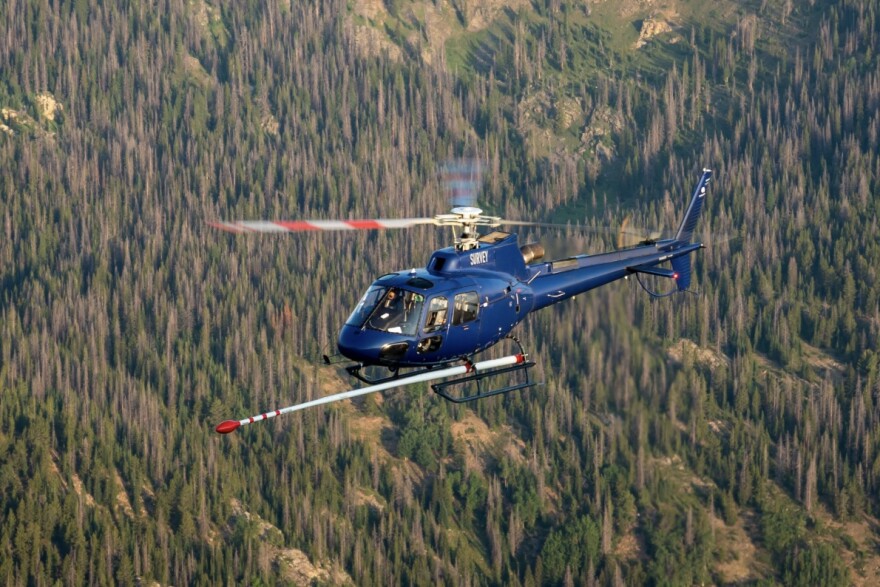Wyoming and the federal government are currently studying the rare earth mineral potential in the state. This comes as companies are eyeing setting up shop.
Wyoming geologists released a new rare earths mapping tool this week after aerial surveying was done this spring. Ideal mining areas have both light and heavy rare minerals. That’s because a combo is needed for things like cell phones.
“The lights make the energy run, the heavies keep it cool so it doesn't blow up in your hand,” said Melissa Sanderson, board director for American Rare Earths.
The company is hoping to be mining deposits on state land between Laramie and Wheatland, known as the Halleck Creek project, by the end of the decade.
Currently there’s not much competition in the U.S. There’s only one active rare earths mine in the U.S., which is based in California. Sanderson said that’s because of permitting and funding logjams, something the feds have been trying to fix.
“The Biden folks were focused on money, and so far, the Trump administration is focused on permitting,” she said.
The concern is China currently dominates the market.
“They have a lot of rare earth. They've also been heavily mining it for 50 years,” Sanderson said. “No deposit lasts forever.”
Sanderson said more funding and streamlining permitting is promising for Wyoming’s rare earth industry – and for U.S. strategic interests. However, Sanderson said realistically, Wyoming won’t be able to supply the entire nation’s needs.

“No country has everything, not China, not Russia, not the U.S. So there's always going to be something that you're going to have to source elsewhere,” Sanderson said. “There's no such thing as 100% made-in – fill in the blank – U.S. supply chain, not going to happen.”
But she pointed to several of Trump’s executive orders that’ll help the U.S. be competitive in the global market. Like, bumping up some federal permitting timelines by speeding up the environmental assessment from one year to 14 days. Conservation groups are sounding the alarm that this will mean little to no recognition of environmental impacts.
However, Sanderson said she’s not overly worried about mining companies getting too relaxed on that front, even with decreasing federal oversight.
“There's always been bad actors, but it's a lot harder to have it these days, because there are a lot of eyeballs,” Sanderson said. “Not even just the official inspectors. Communities are so much more aware now, and so many people have their cell phone in their pocket to take a picture.”
Regardless, Sanderson said public perception could still be an issue. She said even if a company is adhering to best practices, speeding up approval for federal mining permits isn’t a great look.
“One reason that as a society Americans hate mining is because they think of mining as sort of raping and pillaging the earth,” Sanderson said. “It would be very easy to say, ‘Well, there you go. See those rapers and pillagers over there? They all rushed to feed at the 14-day trough, because they knew that their project sucks and they would never have been approved in a real world.’”
To be clear, Sanderson doesn’t think that’s actually true. But she thinks speeding up permitting exposes companies to future litigation if Trump’s executive orders are ever reversed. This doesn’t apply to her company as they got permitted on Wyoming state land.
Sanderson also pointed out that in the frenzy to build out the nation’s rare earths industry, that growth still needs to be done thoughtfully.
“At stake is our economic future, our national defense, but also our national identity as a people,” she said.
Like, not mining in national parks, which some fear Trump’s executive orders could allow for.
Sanderson said not much can be seen at her company's site this summer. They are still doing core sampling and studies on impacts to wildlife migration. She said over the next couple summers, infrastructure development will ramp up.
Over in north-central Wyoming, another company is gearing up to mine rare earths.
Ramaco Resources held a ground breaking July 11 in Ranchester, with Wyoming’s congressional members and U.S. Energy Secretary Chris Wright in attendance. Their project is different from American Rare Earths’ in that they’re using an existing coal mine to extract ore. The hope is to then separate out the valuable rare earth minerals.







